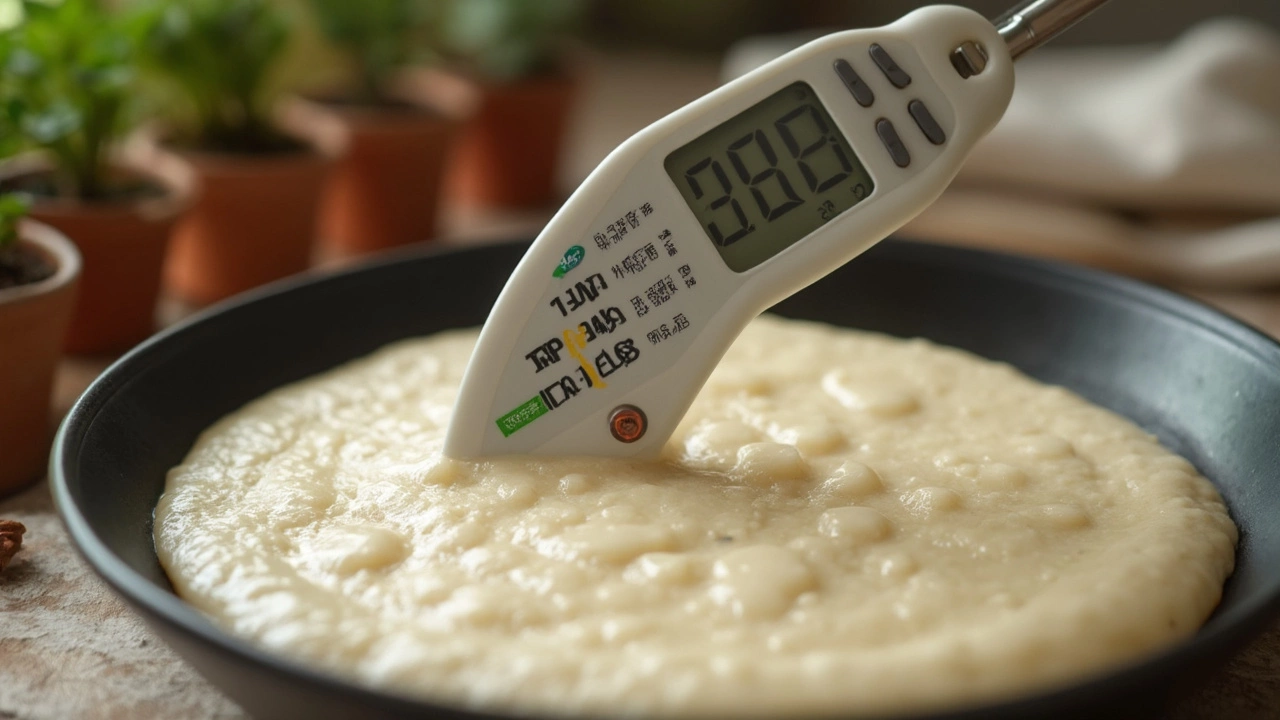Fast Ways to Ferment Dosa Batter Without Yeast
 Feb, 13 2025
Feb, 13 2025
So, you're in the mood for dosas but don't want to wait for hours to ferment the batter? It's a common conundrum, and while they're a staple in many kitchens, the time it takes for dosa batter to naturally ferment can be a drag. Lucky for us, there's no yeast-needed magic to speed things up.
Your first move is realizing temperature is key. The warmer the environment, the merrier the fermentation. If you're somewhere chilly, consider warming up your oven slightly, switching it off, and letting the batter sit in there. Works like a charm!
Next up, consider adding a dash of fenugreek seeds. It’s not just a flavor enhancer but also a natural booster for fermentation. Just toss a few into the mix before letting it sit; they work wonders in giving your batter that perfect bubbly rise.
- Understanding Dosa Batter Fermentation
- Natural Ingredients to Accelerate Fermentation
- Environmental Hacks for Speeding Up the Process
- Common Mistakes to Avoid
Understanding Dosa Batter Fermentation
Fermenting dosa batter is all about a little science magic that turns simple ingredients into that tasty, crispy delight we crave. So, what's happening in that bowl when you start the process? It’s mostly about the interaction between rice, lentils, and some helpful bacteria that chow down on sugars and release carbon dioxide and other compounds.
The Basics of Fermentation
The typical dosa batter is made from a mix of rice and black gram (urad dal). When you soak these, grind them, and leave it all together in a cozy spot, natural fermentation starts. The bacteria and yeast (from air and the grains themselves) gradually create bubbles in the batter, leading to that signature tangy flavor and airy texture.
The Role of Temperature
This fermentation process thrives in warm temperatures. Generally, the ideal range is about 25-30°C (77-86°F). In most kitchens, you might find that it takes anywhere from 8-12 hours, depending on the season and your location.
pH Level Considerations
An interesting fact—you want your batter to reach a pH level of around 4.2 to 4.6 for it to be just right. This naturally acidic environment not only contributes to flavor but also adds a hint of protection against unwanted bacteria.
Common Ingredients
A traditional batch involves simple ingredients:
- 2 parts rice to 1 part urad dal
- A pinch of fenugreek seeds (often added for extra flavor and a boost in fermentation)
- A splash of water to blend everything smoothly
By understanding what's going on at each stage, you can play around with techniques to speed up the process without turning to yeast. Remember, practice makes perfect, and every batch is a chance to learn.
Fun Fact
| Region | Fermentation Time |
|---|---|
| South India (Hot Climate) | 6-8 hours |
| North India (Cooler Climate) | 12-16 hours |
See how climate affects fermentation? Adjust your approach and you'll never have to guess if your dosa batter is ready.
Natural Ingredients to Accelerate Fermentation
Let's talk about the role of some everyday household ingredients that can give your dosa batter a speed boost in the fermentation race. These ingredients not only help your batter ferment faster but also add a subtle depth of flavor that'll make your dosas extra special.
Fenugreek Seeds
Fenugreek seeds are a game-changer. Just a teaspoon added to your rice and dal mixture can work wonders. They're like the unsung heroes of fermenting dosa batter. You see, fenugreek seeds are natural fermenters, which means they help create more bubbles and fluffiness in your batter. No joke, they can cut down the fermentation time by a couple of hours!
Poha (Flattened Rice)
Adding poha or flattened rice is another trick. Soak a handful with your rice and grind it all together. Poha gives the batter a soft texture and boosts fermentation. It holds moisture and facilitates the growth of fermentation-friendly bacteria.
Baking Soda: Use with Caution
Now, this one's a bit controversial. While not exactly traditional, adding a pinch of baking soda can speed things up if you’re really short on time. But be careful; too much, and you’ve got an unpleasant taste on your hands.
Curd (Yogurt): The Old Favorite
Ah, curd, the trusty old kitchen staple. Adding a spoonful of yogurt to your batter can kick-start the fermentation process. The live bacteria in yogurt act like a catalyst, helping your batter get aerated quicker. Plus, it gives a slight tang that we all love in a good dosa.
Temperature as an Ingredient
Okay, I know temperature isn’t an 'ingredient', but hear me out. Using warm water to soak your ingredients can make a slight but effective difference. Warm environments promote faster fermentation, even more so when paired with these natural ingredients.
So, the next time you're rushing and find that your batter isn’t quite there yet, reach for these natural wonders. They're your secret weapon in nailing those perfect, crisp dosas, sans the yeast.

Environmental Hacks for Speeding Up the Process
Trying to get your ferment dosa batter ready in record time? Let's chat about using your environment to its fullest. Temperature plays a major part, so it’s time to manipulate it for our own tasty ends.
Using Your Oven
First up, the good old oven trick. Preheat it to the lowest setting for about five minutes, then turn it off. Place the batter inside with the oven light on. This creates a warm, cozy environment that encourages faster fermentation without yeast.
Harnessing Natural Warm Spots
Have you ever just hugged your water heater on a cold day? Kind of magical, right? Find those naturally warmer spots around your home, like on top of the fridge or near a heater, and snug your batter there.
"Temperature control is crucial in fermentation. Consistent warmth creates an active culture, speeding up the biochemical reactions needed," says Priya Mehta, a renowned food scientist.
Don’t Underestimate the Sun
If you’re blessed with sunny weather, use it! A sunny windowsill can be an unexpected hero. Just cover the bowl with a damp cloth to prevent the top from drying out.
Special Tip: Water Temperature
And don't forget about water temperature in the initial batter mix. Using lukewarm water when blending can give the process a head start.
| Method | Estimated Time Reduction |
|---|---|
| Oven Method | 2-3 hours |
| Sunny Windowsill | 1-2 hours |
| Warm Spots at Home | 1-2 hours |
So, there you have it. Swap out the long waiting times with these hacks, and you’re golden. Your perfectly fluffy dosas will be ready before you know it!
Common Mistakes to Avoid
Getting the perfect ferment dosa batter isn't as straightforward as it looks. Let's break down some classic blunders that could be slowing down your dosa game. Avoid these, and you'll be flipping those crispy delights in no time.
Using Cold Water
First up, using cold water when grinding your batter is a no-go. Cold hinders the fermentation process, which makes waiting time longer. Instead, always opt for lukewarm water to give the natural bacteria a cozy start.
Skipping the Soaking Time
Impatience can be your enemy. Not soaking the rice and lentils long enough before grinding affects the texture and fermentation. Make sure you give it a good 4-6 hours soak for the best outcome.
Ignoring the Environment
If your kitchen is like Antarctica, your dosa batter fermentation is bound to slow down. Find the warmest spot, or use a modern trick like a pre-heated, turned-off oven to create that optimal environment.
Tight Sealing
Another common mistake is sealing the container too tightly. Ferment dosa batter needs to breathe. Loosely cover it to allow air and keep things moving. Trapping moisture can make things soggy, and nobody wants that.
Overloading Fenugreek Seeds
While adding fenugreek can speed up the fermenting process, overloading it can give a bitter taste. Just a small spoonful is enough to do the trick.
Follow these tips, and you'll say goodbye to sluggish fermentation. Keep it simple, tweak where necessary, and see the difference in your dosa prep routine.